Create
Vintage Pinellas: The Penguin
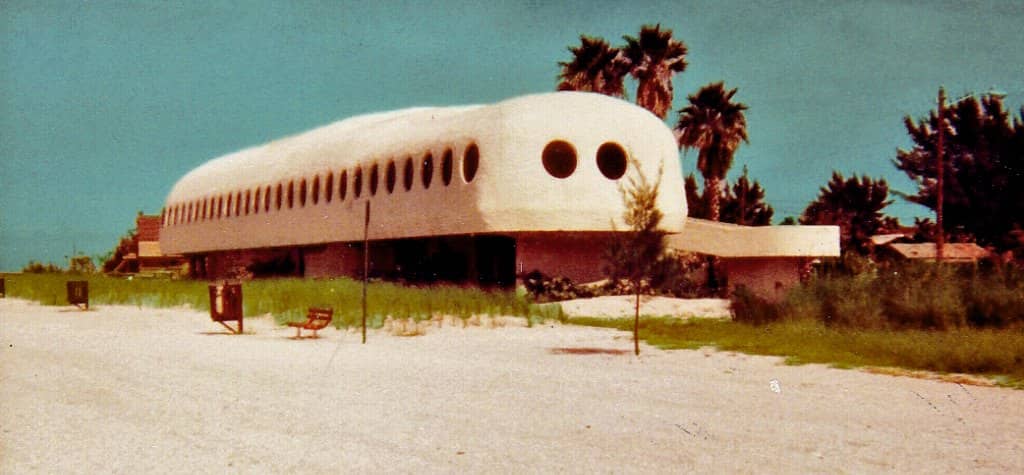
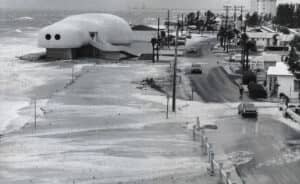
The Penguin Restaurant in the mid ’70s, letting a tropical storm roll right over and under. Jackie Greene/ St. Petersburg Times/ZUMA Press.
The most unusual building in Pinellas County met the wrecking ball in 1999, but the title remains unchallenged to this day.
At 8000 Gulf Boulevard, Treasure Island – near the southern tip of the area known as Sunset Beach – the Penguin Restaurant was a tri-humped marvel of modern architecture, a 250-foot-long dome made of high-tensile concrete sprayed over steel rebar ribs. Its 7,000 contiguous square feet stood atop pilings 16 feet off the sand, 29 large porthole windows offering diners unparalleled views of shore and sunset.
The Penguin was a smooth-sided, snow-white concrete igloo, designed with curves, without corners or seams, so that hurricane winds would have nothing to latch onto and tear apart.
Seating 260, the Penguin’s specialty was prime rib of beef, which owner/chef Winston Hunter sliced tableside from a little motorized cart. Hunter’s Yorkshire pudding was also well-known. Seafood, of course, was always on the menu.
Yet the food, and the full bar, were almost secondary. When you went to the Penguin, you went to that weird-looking place out at the beach. You parked underneath the kitchen – by necessity the largest part of the dome – and walked up the long ramp into something else altogether.
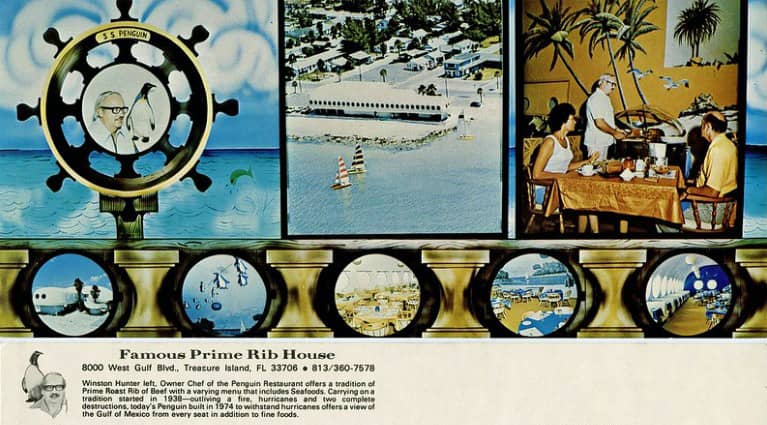
1970s postcard (detail) with Hunter and his restaurant in their prime.
In 1972, Hurricane Agnes had destroyed the old wooden Penguin Restaurant. In the restaurant’s three-decade history, storms had damaged or totaled it numerous times.
Architect Ronn Ginn, 89, remembers the day Hunter told him he had the guarantee of a $300,000 loan from the Small Business Association’s Disaster Relief Fund, with a 1 percent interest rate, provided he could make the “new” Penguin virtually hurricane-proof.
Says Ginn, who’s still a working architect: “It was not designed to quote-unquote be different. It was designed to meet the requirements we were given by the SBA.” And guidelines set down by the by Federal Disaster Assistance Administration, under the auspices of the Department of Housing and Urban Development, which would evolve into the independent Federal Emergency Management Agency (FEMA) in 1979.
Hunter, Ginn, recalls, “was a great client. He said ‘Ron, it’s your job. I’m a chef. I’ve been a chef all my life, and people love my food. I’m gonna stick to what I know.’”
And Ronn Ginn loved a challenge.
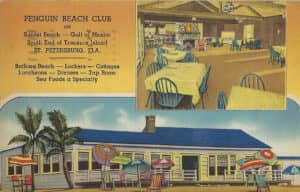 In the 1930s, every beach community in Pinellas County had its own private club, where the reasonably well-to-do could swim, engage in light water and sand sports, dine, drink, dance and play cards; they were also leased out, on occasion, for public civic and club meetings. The Penguin Club opened in August 1939.
In the 1930s, every beach community in Pinellas County had its own private club, where the reasonably well-to-do could swim, engage in light water and sand sports, dine, drink, dance and play cards; they were also leased out, on occasion, for public civic and club meetings. The Penguin Club opened in August 1939.
“The main building of the club consists of a spacious lounge room and dining room separated by a semi-circular bar and a great fireplace,” gushed the St. Petersburg Times in its “Over the Causeways” section. “Knotty pine paneling with rustic cypress trim and an inverted ceiling add coziness to the lounge room, while the dining room is finished with mahogany stain walls and trimmed in rich walnut.”
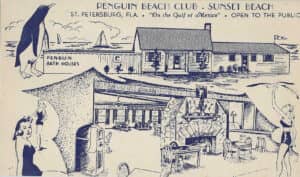 The “well-planned bathhouse,” the story said, “has accommodations for 100 guests.” Searchlights were aimed at the beach for after-dark swimming.
The “well-planned bathhouse,” the story said, “has accommodations for 100 guests.” Searchlights were aimed at the beach for after-dark swimming.
“Theme” nights were popular – the newspaper duly reported every guest at the Penguin’s “Wild West Night,” bridge, volleyball and badminton contests (“Prizes of Old Spice perfume were given the winners”), a Mexican-themed wedding and more. Members frequently went bowling together.
The founders were Hubert McNally and Arthur Barnes, proud members of the St. Petersburg Jaycees. McNally and his wife Elizabeth had an infant son, Terrence, born the previous November at St. Anthony’s Hospital.
 Terrence McNally would grow up to become the Tony-winning playwright of Kiss of the Spider Woman, Ragtime, Master Class, Love! Valour! Compassion! and others. The New York Times called McNally “The Bard of American Theater.”
Terrence McNally would grow up to become the Tony-winning playwright of Kiss of the Spider Woman, Ragtime, Master Class, Love! Valour! Compassion! and others. The New York Times called McNally “The Bard of American Theater.”
His parents sold the Penguin Club in 1941, and moved with young Terrence to Port Chester, N.Y.
A hurricane severely damaged the Penguin Club in June, 1944, destroying a seawall and other barriers, and a fire two months later sealed the deal, necessitating a near-total rebuild.
 Five years on, then-new owners Stephen and Clara Girard rebuilt the old place again – elevating it off the sand via short wooden pilings – after a Labor Day blow all but obliterated it for a second time.
Five years on, then-new owners Stephen and Clara Girard rebuilt the old place again – elevating it off the sand via short wooden pilings – after a Labor Day blow all but obliterated it for a second time.
The Girards declared the Penguin a restaurant open to the public – a private club no more – in 1952.
Clara Girard sold the Penguin in 1959 before departing for a lengthy European visit; by ’63, however, she was back, in full ownership mode again, and had hired Winston Hunter as head chef. Hunter’s specialty was prime rib of beef with Yorkshire pudding.

Battered at the back door: The Penguin in 1964. George Trabant/St. Petersburg Times/ZUMA Press.
The 1960s brought more harsh tropical weather, and another damaging fire, and by decade’s end Hunter had convinced Girard to sell the battered restaurant to him.
Things were going just swell until Hurricane Agnes arrived, near the end of June in 1972. Hunter estimated the damage at around $100,000 – the entire floor had fallen through, followed by the roof – and he boldly told the Times “We’re coming back. We’re not discouraged.”
How he was going to pull it off, he had no idea. So he went looking for an architect, and he found Ronn Ginn.
According to the land survey, Hunter owned everything from the road to the water. The first step was putting up the new place closer to Gulf Boulevard, farther away from the pummeling surf.
The SBA insisted Ginn’s design had to withstand winds up to 150 miles per hour, stand well above any possible tide surge, and be wheelchair accessible.
Ginn had recently been contacted by a South Florida engineer who’d created a new, hyper-strong form of concrete, and used it to great effect in the hurricane-battered Caribbean. Mixing cement with a chemical additive produced a compound that could withstand 12,000 pounds of pressure per square inch, four times the norm for structural concrete in 1972.
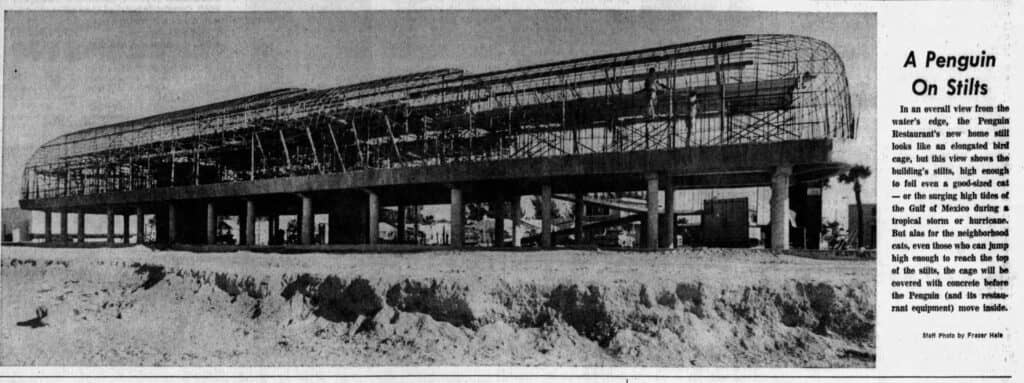
St. Petersburg Times, Jan. 14, 1974.
The wet concrete could be sprayed pneumatically, with high pressure, over a ribcage of steel rebar, producing a virtually impenetrable eggshell finish.
Ginn had his builder drive 55 steel pilings, filled with concrete, as much as 85 feet into the ground. The restaurant’s floor, when all was said and done, stood 16 feet off the Sunset Beach sand.
At the top – 60 feet in the air – the concrete shell was 3 and ½ inches thick. It was eight inches at its base, where the floor was welded to the pilings.
There were no stairs to carry patrons up to the restaurant from the ground-level parking. Instead, Ginn designed a massive, dogleg ramp up the side of the building, which fulfilled the SBA requirement, but which Hunter felt was more aesthetically pleasing than stairs, for those who could manage it (although he did install a discreet elevator).
Inside, says Ginn, Hunter wanted it all open, from one end to the other with no columns, the better to ride his cart between the kitchen (the only room, aside from the restrooms, with a dividing wall), the bar and the dining area.
It was all part of the Penguin experience.
Some visitors have thought the vast white caves of the interior seemed too barren while others, myself included, felt comfortable in the organic vaulted space, albeit, return to the womb and all that psychological stuff … a flat plastered ceiling could have been dropped from the curve to accommodate the lighting and air conditioning ductwork which runs between the shells, but Ginn opted, I think correctly, to continue the curvature.
Charles Benbow, St. Petersburg Times/July 10, 1974
It may not have been pretty, but it was distinctive.
 “They flew a reporter and photographer down from the Boston Herald,” Ginn remembers. “They didn’t believe this building was going to withstand anything. They thought I was a blowhard, just another blowhard architect.”
“They flew a reporter and photographer down from the Boston Herald,” Ginn remembers. “They didn’t believe this building was going to withstand anything. They thought I was a blowhard, just another blowhard architect.”
Architects, he laughs, “don’t blow hard.” The rules and regulations they follow are strict and to-the-point.
Only Mother Nature, it seemed, was blowing hard. Never, in the quarter-century it occupied the real estate at 8000 Gulf Boulevard did the Ginn Penguin shudder or shake from the pounding of hurricane wind or water.
Due to illness, Hunter sold the Penguin in 1980, and over the following decade it changed hands, and names, several times. It became Bedrox, a gay and lesbian dance club, in 1989 (so named because the building resembled something out of The Flintstones). The new owners painted the futuristic façade pink.
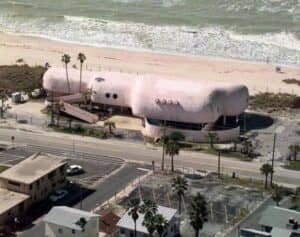
Bedrox. Photo: Treasure Island Historical Society.
Bedrox rolled along for a while, attracting the enthusiasm of large crowds – and irritation from its Sunset Beach neighbors, who regularly complained about drunkenness and brawling, nudity and even sex on the beach after dark.
The club’s owner Kim Costanza filed for bankruptcy in 1997, and a sale to the City of Treasure Island was proffered.
Using Penny For Pinellas tax money, the city paid Costanza $1,325,000 for the building and the acre-plus of prime beachfront property. “It really has to be open to the public,” a consulting architect told the Tampa Tribune. “However long it takes to accomplish that remains to be seen. It’s just a shell.”
“I hate to see the building itself go,” Treasure Island mayor Leon Atkinson said. “Because it’s such an icon.”
Nevertheless, it was decided to raze Bedrox and construct a public access pavilion on the site, with a gazebo, playground, restrooms and re-planted beds of sand-protecting sea oats.
On July 26, 1999, the city’s designated demolition contractor aimed a 5,300-pound solid steel wrecking ball at the erstwhile Penguin. “They didn’t really explain to him how strong it was,” Ronn Ginn recalls gleefully, “because they didn’t know. But that building had been there for almost 50 years. He didn’t understand that the concrete we poured in there got stronger with age.
“Here comes this big ol’ crane with a huge wrecking ball. Usually, you hit something like that, and it’s gone.
“But that big wrecking ball, instead of going through the dome, it bounced off.”
Eventually, of course, the curve was crushed and the building demolished. The Treasure Island Beach Pavilion was dedicated in 2013.


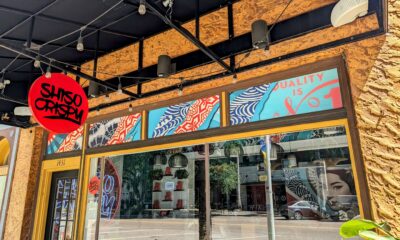

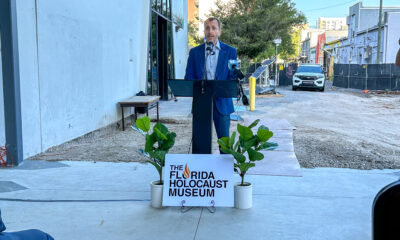



Nancy Haggerty
February 23, 2024at4:29 pm
I took a trip to Florida with my then boyfriend Kent in the mid seventies and we went to the Penguin for lunch. It was quite nice…turns out his relative-uncle I believe was Winston Hunter! He came by our table to deliver our meal personally and was a lovely man! The best view on that coast at the time!
Katrina Anderson
January 4, 2024at2:49 am
I lived in Indian Shores & Madiera Beach from 1992-2001.
Bedrox was a fun vibe. VERY cool building right on the water
Tracks in Tampa was a true club with 3 rooms and a huge stage.
Donna E Rogers
December 16, 2022at4:41 pm
When I was a kid in 1967/1968 we lived at 7719 Gulf Boulevard. My best friend Bridget Cook’s mother worked at the Penguin. She worked there for years!
Romie Morett
December 15, 2022at2:12 pm
Thank you for this article! We have adopted Sunset Beach as “our beach” because of the wonderful beach, the gazebo, restrooms, children’s play area and shade the pines provide. I enjoy learning about the history of places we visit and would have never imagined everything your article described.
Teresa Britt
December 14, 2022at9:16 pm
From begining to end of sunset beach,There we’re fun places to go eat drink and be marry! Beachnuts Cadys’ Sealion legion Nick’s & last but NOT LEAST? a penguins igloo full of prime rib ,To the Penis & Clam palace,I remember going there with a coworker and you had to pay to park,That was my reason I never went again.Different strokes for different folks.
Steve
December 12, 2022at7:24 pm
I don’t remember the “Penguin”, but I do remember going to Robbie’s Pancake House in Treasure Island for Buckwheat pancakes as a kid in the mid ‘70’s.
Didn’t live in the area, but when I visited my grandparents, who lived on Gulf Blvd, we would frequent Robbie’s for breakfast.
Haven’t had as good a buckwheat pancake since.
-Robbie’s Fan #1
Britt
December 12, 2022at1:03 am
When i was growing up, my parents bought a condo on sunset beach. My dad found that place one day and found out that it was, at that time, a gay bar. So, my dad nicknamed it the hidden pickle, and thats what i know it as. Lol
Crystal Dunn
December 11, 2022at6:10 pm
I loved seeing the pictures and reading the great article. My husband, Craig Dunn and I Crystal performed music fior dinner and dancing in the 1980’s when it was called Captain Nemos and owned by a Polish couple. We loved working there,
Pamela Bell
December 11, 2022at6:06 pm
Thank you for posting this story. My Aunt was Clara Girard and I grew up hearing about her owning that restaurant. I’ve shared it with my nieces and nephews as their Dad was named after her husband Stephen Girard.
LINDA BASSETT
December 11, 2022at4:20 pm
I remember growing up a few blocks from the Penguin, my parents owned the Gulf Spray motel. Great place to grow up. We preferred the beach club wooden version to the later concrete, but the roast beef was great. Those storms seem to pass by my parents place beachfront but the damage surrounded us. Sand covering some cottages to the roof tops. When the Penguin closed it was a great loss not to have a restaurant down the block.
Scott Simmons
December 10, 2022at4:34 pm
Thanks Bill. Another great story that brings back memories from the old days. The last time I had Yorkshire Pudding that good was when Bob Shoemaker and I visited Trevor and Sharon Neal at their home in Sheffield in 1989. That’s mentioned in Chapter 24 of the book Trevor and I hope to publish soon, “Searching For Romance in Durango.” Scott